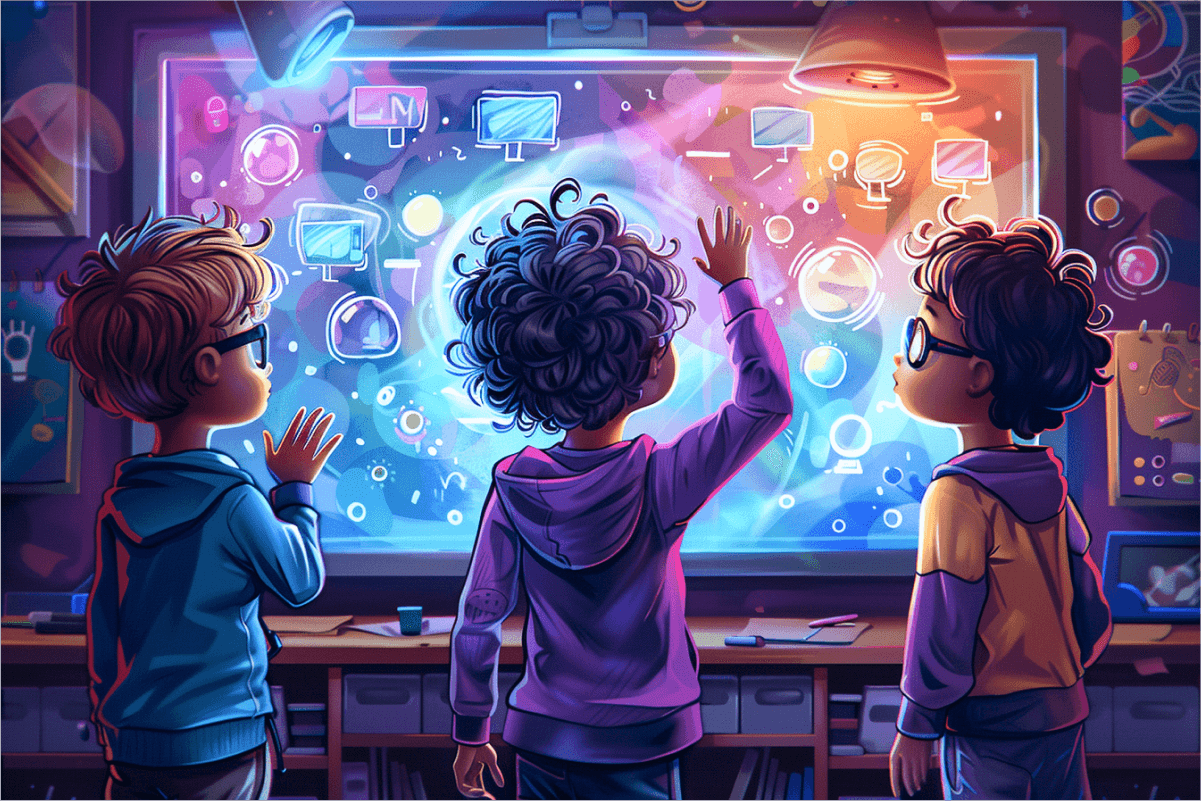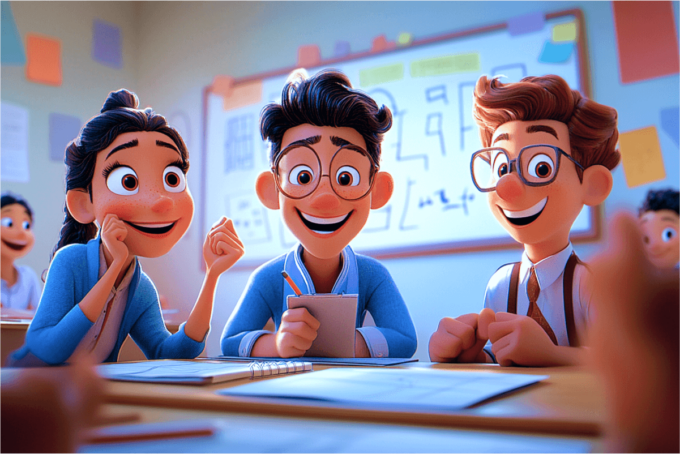Visual learners have unique strengths and preferences when it comes to learning. Incorporating activities that cater to their visual learning style can greatly enhance their understanding and retention of information. In this article, we will explore various classroom activities for visual learners.
Understanding the Visual Learning Style
Before diving into the classroom activities, let’s first understand the characteristics of visual learners.
Visual learners primarily rely on visual aids and imagery to process and remember information. They benefit from seeing concepts in action, such as through diagrams, charts, and illustrations. These learners have a keen eye for details and tend to think in pictures.
Visual learners often prefer to sit in the front of the classroom to have a clear view of the whiteboard or projector screen. They may also enjoy using color-coded notes or highlighters to organize information in a visually stimulating way. When studying, visual learners tend to create mind maps or flashcards to visually represent relationships between different concepts.
Characteristics of Visual Learners
Visual learners primarily rely on visual aids and imagery to process and remember information. They benefit from seeing concepts in action, such as through diagrams, charts, and illustrations. These learners have a keen eye for details and tend to think in pictures.
Visual learners often excel in subjects like art, geography, and geometry, where visual representation plays a significant role in understanding complex concepts. They may struggle more with purely auditory learning activities, such as lectures without visual aids, as they thrive on visual stimulation to fully grasp new information.
Benefits of Visual Learning
Visual learning offers numerous benefits for students. Firstly, it helps enhance comprehension and retention, as visual information is processed faster and stored in long-term memory more effectively. Additionally, visual aids promote engagement and improve concentration, leading to higher levels of motivation and interest in the subject matter.
Furthermore, visual learning can cater to different learning styles within a classroom, making it a versatile teaching approach. By incorporating visual elements into lessons, educators can create a more inclusive environment that accommodates the diverse needs of students with varying learning preferences. This approach fosters creativity and critical thinking skills, as visual learners are encouraged to analyze and interpret information in a way that resonates with their unique learning style.
Strategies for Teaching Visual Learners
To effectively engage visual learners, educators can incorporate various strategies into their teaching methods.
Visual learners are individuals who process information best when it is presented visually. They often prefer to see information in the form of pictures, diagrams, or charts, rather than just hearing or reading about it. Understanding the unique needs of visual learners is crucial for educators looking to create an inclusive learning environment.
Incorporating Visual Elements in Lessons
One approach is to integrate visual elements into lessons. This can be achieved through the use of pictures, diagrams, and charts that represent key concepts. Educators can also encourage students to create their own visual representations of information, fostering creativity and active learning.
By incorporating visual elements, educators can help visual learners make connections between ideas and improve their understanding of complex topics. Visual aids can also make learning more engaging and memorable, as they appeal to the visual senses and cater to the strengths of visual learners.
Using Visual Aids Effectively
Visual aids, such as slideshows or multimedia presentations, can be powerful tools to support visual learners. It is important to ensure that these aids are clear, concise, and visually appealing. Emphasizing the key points and organizing information in a logical manner will aid in comprehension.
When using visual aids, educators should consider the preferences of visual learners, such as using color coding to highlight important information or incorporating visual metaphors to make abstract concepts more concrete. By tailoring visual aids to the needs of visual learners, educators can enhance the learning experience and help students retain information more effectively.
Classroom Activities for Visual Learners
Engaging visual learners through hands-on activities can significantly enhance their learning experience. Visual learners thrive when presented with information in a visual format, making it easier for them to process and retain knowledge.
Visual learning activities cater to the strengths of these students by tapping into their preference for images, spatial understanding, and color-coded information.
Interactive Whiteboard Activities
Utilizing interactive whiteboards allows teachers to create dynamic and visually stimulating activities. Concepts can be presented through interactive games, puzzles, and quizzes, allowing students to actively participate in the learning process. The use of multimedia elements such as videos, animations, and interactive diagrams can further enhance engagement and comprehension.
Interactive whiteboard activities not only cater to visual learners but also accommodate different learning styles by providing a multi-sensory learning experience.
Art and Craft Projects
Incorporating art and craft projects allows visual learners to showcase their creative side while internalizing key concepts. For instance, students can create visual representations of historical events or scientific processes, enabling them to grasp complex ideas through their own artistic expression. Art and craft projects encourage creativity, critical thinking, and hands-on learning, making the educational experience more interactive and memorable.
These projects also promote collaboration among students, as they work together to bring their visual creations to life, fostering a sense of teamwork and shared accomplishment.
Diagram and Mind Map Exercises
Creating diagrams and mind maps can aid visual learners in organizing and connecting information. By visually mapping out relationships between ideas or steps in a process, students can develop a deeper understanding of the subject matter. Diagrams and mind maps provide a visual structure that helps visual learners see the “big picture” and how individual components relate to one another.
These exercises not only enhance comprehension but also improve students’ analytical skills as they learn to identify patterns, make connections, and synthesize information visually.
Technology Tools for Visual Learning
Technology offers a wide range of tools that can support visual learners in their educational journey.
Visual learning is a powerful approach that leverages images, diagrams, and videos to enhance comprehension and retention of information. By engaging with visual content, students can better grasp abstract concepts and make connections between different ideas.
Educational Video Platforms
Platforms hosting educational videos provide visual learners with an alternative way to learn and absorb information. These videos often incorporate animations and visualizations that make complex concepts more accessible and engaging.
Furthermore, educational video platforms offer the flexibility of pausing, rewinding, and replaying content, allowing visual learners to control the pace of their learning and revisit challenging topics as needed.
Graphic Design Software for Education
Graphic design software offers visual learners an opportunity to create visually appealing presentations, infographics, and diagrams. By immersing themselves in the design process, students can reinforce their understanding of the content while developing valuable digital literacy skills.
Moreover, graphic design software enables students to express their creativity and customize visual materials to suit their learning preferences. This hands-on approach not only enhances their comprehension but also fosters a sense of ownership and pride in their work.
Assessing the Progress of Visual Learners
Assessment is an important component in measuring the progress and understanding of visual learners.
Visual learners process information best when it is presented in a visual format. They thrive when they can see and interact with information in a way that makes sense to them. Therefore, it is crucial to tailor assessment techniques to cater to their preferred learning style.
Visual-Based Assessment Techniques
Designing assessments that rely on visual comprehension can provide a more accurate measure of visual learners’ understanding. For example, instead of traditional written exams, visual learners can be assessed through projects, presentations, or visual quizzes.
Visual projects allow students to showcase their understanding in a creative and visually appealing manner. Presentations enable them to explain concepts using images, graphs, and diagrams, enhancing their ability to communicate visually. Visual quizzes, such as matching images to concepts or labeling diagrams, can assess their comprehension in a way that aligns with their learning preferences.
Feedback and Improvement Strategies for Visual Learners
Providing constructive feedback is crucial for the growth of visual learners. Offering specific suggestions related to visual organization, clarity, and usage can help them enhance their visual communication skills and empower them to become more effective visual learners.
Encouraging visual learners to seek feedback from peers can also be beneficial. Peer evaluations can provide different perspectives and insights, helping visual learners refine their visual presentations and projects further. This collaborative approach not only fosters a sense of community in the classroom but also enhances the learning experience for visual learners.
In conclusion, incorporating simple yet powerful classroom activities can create a vibrant and engaging learning environment for visual learners. By understanding and catering to their unique needs, educators can maximize their potential and promote deeper understanding of the subject matter. So why not unlock the full potential of visual learners by embracing these strategies and activities in your classroom?
You might be interested:



